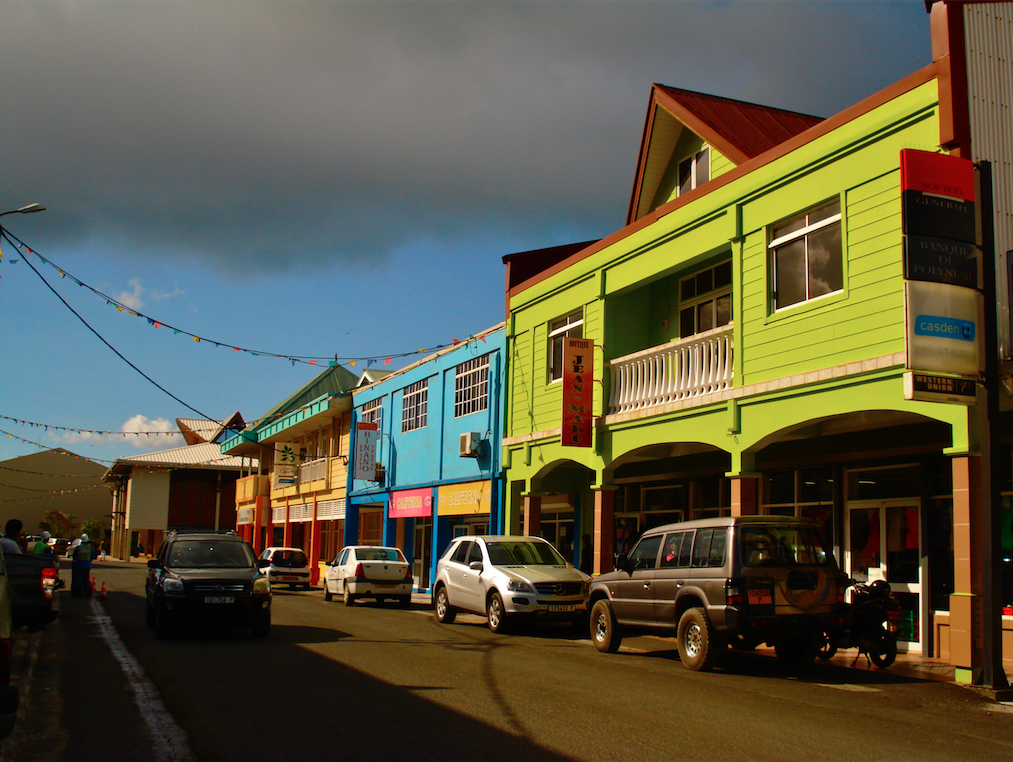La Orana! (Greetings) Since the beginning of winter break, I’ve been counting down the days until my arrival in paradise. Along with 24 students and two professors, I embarked on our journey to study astronomy of the Southern Skies in French Polynesia. We split our three weeks among four different islands: Tahiti, Mo’orea, Bora Bora and Ra’iātea.
Our first stop was Tahiti, the largest island of French Polynesia. The streets consisted of colorful house gates, exotic plants, occasional reckless driving and stray dogs. Immediately, I noticed how friendly the Tahitians were. Every time we drove by, strangers greeted us with a smile and a “hang loose” hand gesture. Tahiti was noticeably more industrialized than the other islands. Still, about 80 percent of items are imported from France, the United States, Australia, China and Japan. It was also the only island we visited that had a bussing system. Tahiti had more markets, restaurants and companies, which contributed to its lively feel.
Although French Polynesia receives financial funds from France, our tour guide said it is pretty detached from the European country. French Polynesia has its own Tahitian president, and each city has a mayor. Tahitians are said to have mixed feelings about being colonized: some feel they should gain their own independence, while others believe support from France is crucial to the country’s economy. French Polynesia is not a part of the Euro currency system either. Instead, Tahitian Franks are used. Each island is unique for its economic specialty. Bora Bora is known for tourism, Ra’iātea generates the most pearls, and Tahiti produces vanilla. Our tour guide encouraged us to think of the islands as “states” that make up French Polynesia.
On our first night, we had the chance of seeing Sirius—the brightest star in the sky. While Sirius is nearly 8.5 light-years away from Earth, it is one of the closest stars to our planet. Although the name Sirius is derived from the Greek word “Seirios,” meaning “glowing” or “scorcher,” it is also known as the “New Years Star.” At midnight on New Year’s Eve, Sirius reaches its highest point in the sky. By using Orion to help navigate Sirius, the star can be found in the same location during the first week of January.
I’ll never forget the day we went on a safari jeep ride. Standing on the seats of a roofless vehicle, we got a closer view of Tahiti’s mountains as we drove up narrow hills. We simultaneously threw our hands in the air and took in the French Polynesian breeze. At times, we encouraged classmate rivalry, and urged our tour guides to drive faster to beat the other jeeps.
Mo’orea, meaning “Yellow Lizard,” was memorable for two reasons. For one, I had the chance of swimming underwater with stingrays and other fish. I’ll admit, I was terrified. All I could remember was how Steve Irwin, the Australian wildlife expert, died of a stingray attack. Also, hearing our underwater guide, Vincent, say it was his first day on the job, didn’t cure my nervousness. Of course, he was kidding! Surprisingly, the stingrays were very friendly, and the view was more serene than I could have imagined.
The following day, we went to a Tiki hut and took part in Tahitian cultural traditions. My classmates and I weaved palm baskets, tie-dyed surrongs, created floral crowns and learned to do the ‘ote,’a dance which is sometimes confused for the Hawaiian hula. The ‘ote’a consists of aggressive hip shaking, while the hula dance is focused on storytelling using hands. Additionally, the Tahitian dance is only accompanied by cultural drums, but no singing.
Bora Bora was the most commercialized island we visited. At the same time, it was breathtakingly beautiful. The waters showcased different shades of colors from light teal to dark blue. We went on our second safari jeep ride including a visit to a local Tahitian painter, and pearl farm. Unfortunately, it rained a lot while we were there. Nonetheless, we tried to take advantage of the sunny days as often as we could.
During our time in Ra’iātea, we visited a vanilla farm, went on more excursions, and had lunch in the middle of the ocean. But nothing compared to our 12-mile, uphill hike. My classmates and I started at 9:00 a.m. and finished at 4:30 p.m. The slippery, moss-glazed rocks, sharp plants that kept brushing against our legs, or the narrow pathways couldn’t prevent us from seeing the anticipated view overlooking the island. Simply put, it was indescribable! On our way up, we came across a Tiare Apetahi, a rare Tahitian flower, which represents the legend of a tragic love story. Our tour guide explained to us that the flower is nearly 300 years old, and can only be found at Ra’iātea’s Mount Temehani. In the morning, Tiare Apetahi blossoms with a popping sound. At night, the flower closes, again, making the same sound. This process repeats itself daily.
There are many lessons that can be taken away from my time in French Polynesia. One, to look at the stars more often, for they are a reminder of just how big our universe is. Secondly, enjoy the outdoors, especially if a beach is across from your hotel. Third, it’s good to challenge yourself, even if a 12-mile hike feels like a disastrous task in 90 degree heat. Lastly, language barriers might be a challenge, but this saying couldn’t ring more true than in these islands, “We all speak the same language with a smile.”
Eden Checkol can be reached at chec7168@stthomas.edu.



